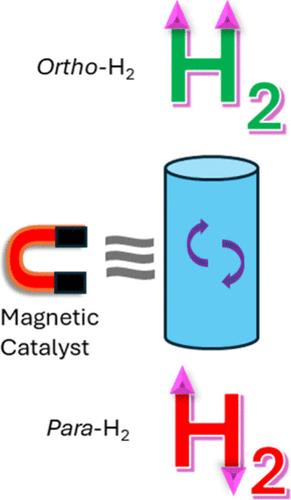当前位置:
X-MOL 学术
›
Ind. Eng. Chem. Res.
›
论文详情
Our official English website, www.x-mol.net, welcomes your
feedback! (Note: you will need to create a separate account there.)
Ortho- to para-Hydrogen Conversion Kinetics: New Experimental Data and an Industrial Perspective
Industrial & Engineering Chemistry Research ( IF 3.8 ) Pub Date : 2024-11-11 , DOI: 10.1021/acs.iecr.4c02059 Sanne Wijnans, Rafal Zietara, Emily Pearson, Michiel Boele, Michael A. Reynolds
Industrial & Engineering Chemistry Research ( IF 3.8 ) Pub Date : 2024-11-11 , DOI: 10.1021/acs.iecr.4c02059 Sanne Wijnans, Rafal Zietara, Emily Pearson, Michiel Boele, Michael A. Reynolds

|
Hydrogen is a remarkable molecule with applications ranging from refining and petrochemicals to medicine, to space travel and the energy transition. It consists of two spin isomers, namely orthohydrogen (ortho-H2) and parahydrogen (para-H2), that are separated in energy by only 1.455 kJ/mol. Chemically, these isomers are indistinguishable, yet each isomer has its own unique physical properties including thermal conductivity, optical behavior, and specific heat capacity. These physical traits are important during hydrogen liquefaction because the para-H2 form is more stable at cryogenic temperatures (i.e., T < 77 K). In the context of energy transition, the production and supply of liquid hydrogen requires the application of a catalyst in liquefaction plants to induce hydrogen isomer interconversion via the process known colloquially as “spin-flipping.” The same catalyst can also improve brightness in neutron spallation sources, or enable the parahydrogen induced hyperpolarization (PHIP) technique used in magnetic imaging. Although the current preferred catalyst for these applications is a class of iron oxide materials, only a limited set of catalyst performance data is available. A confluence of this data was measured more than half a century ago, often using catalyst samples synthesized at lab-scale, and/or derived under reaction conditions irrelevant for practical application. Consequently, the few widely cited kinetic models for this system were developed by fitting data against an even smaller subset of this data limited by temperature or pressure conditions, all from the 1950s/1960s. It is reasonable to question if these models have predictive capabilities that are relevant for the current-day design using today’s commercial catalyst. Our work compares three of these kinetic models against new Ionex Type O–P Catalyst conversion data, spanning >300 data points across a broad and industrially relevant temperature–pressure window, and four published experimental data sets. The new data were measured in a custom-built cryostat, as part of a joint program between Quantum Technology Corporation and Shell. The data were analyzed using a custom Python script. A Langmuir–Hinshelwood model used by Donaubauer, and a similar model by Zhuzhgov/Buyanov showed nonphysical behavior under certain experimental conditions. These models are therefore unsuitable for a design of any real-world application. However, our work finds that three of the literature kinetic models do perform reasonably well in predicting the para-H2 outlet concentration of the experiments conducted in this study, provided that the reaction system remains in the gas phase. The two best performing models are the first-order model by Donaubauer et al. (R2 = 0.98), and the model by Wilhelmsen et al. if the model parameters are modified. Thus, our conclusion is that these models do offer relevant predictive capabilities for current-day process design, and using a commercial catalyst.
中文翻译:

邻位氢到对位氢转化动力学:新的实验数据和工业视角
氢是一种非凡的分子,其应用范围从炼油和石化到医学,再到太空旅行和能源转型。它由两种自旋异构体组成,即正氢 (ortho-H 2) 和仲氢 (para-H 2),它们的能量分离仅为 1.455 kJ/mol。在化学上,这些异构体无法区分,但每种异构体都有其独特的物理性质,包括导热性、光学行为和比热容。这些物理特性在氢液化过程中很重要,因为 para-H 2 形式在低温(即 T < 77 K)下更稳定。在能源转型的背景下,液氢的生产和供应需要在液化厂中应用催化剂,通过俗称“自旋翻转”的过程诱导氢异构体相互转化。相同的催化剂还可以提高中子散裂源的亮度,或实现磁成像中使用的多氢诱导超极化 (PHIP) 技术。尽管目前这些应用的首选催化剂是一类氧化铁材料,但只有有限的催化剂性能数据可用。这些数据的汇合是在半个多世纪前测量的,通常使用在实验室规模合成的催化剂样品,和/或在与实际应用无关的反应条件下得出的催化剂样品。因此,该系统为数不多的被广泛引用的动力学模型是通过将数据与受温度或压力条件限制的更小的数据子集拟合而开发的,这些数据都来自 1950 年代/1960 年代。 有理由质疑这些模型是否具有与使用当今商业催化剂的当前设计相关的预测能力。我们的工作将其中三个动力学模型与新的 Ionex 型 O-P 催化剂转化数据进行了比较,这些数据跨越了广泛且工业相关的温度-压力窗口内的 >300 数据点,以及四个已发布的实验数据集。新数据是在定制的低温恒温器中测量的,这是 Quantum Technology Corporation 和壳牌联合计划的一部分。使用自定义 Python 脚本对数据进行分析。Donaubauer 使用的 Langmuir-Hinshelwood 模型和 Zhuzhgov/Buyanov 的类似模型在某些实验条件下显示出非物理行为。因此,这些模型不适用于任何实际应用的设计。然而,我们的工作发现,如果反应系统保持在气相,则三个文献动力学模型在预测本研究中进行的实验的 para-H 2 出口浓度方面确实表现得相当好。如果修改了模型参数,则性能最好的两个模型是 Donaubauer 等人的一阶模型 (R2 = 0.98) 和 Wilhelmsen 等人的模型。因此,我们的结论是,这些模型确实为当今的工艺设计和使用商业催化剂提供了相关的预测能力。
更新日期:2024-11-11
中文翻译:

邻位氢到对位氢转化动力学:新的实验数据和工业视角
氢是一种非凡的分子,其应用范围从炼油和石化到医学,再到太空旅行和能源转型。它由两种自旋异构体组成,即正氢 (ortho-H 2) 和仲氢 (para-H 2),它们的能量分离仅为 1.455 kJ/mol。在化学上,这些异构体无法区分,但每种异构体都有其独特的物理性质,包括导热性、光学行为和比热容。这些物理特性在氢液化过程中很重要,因为 para-H 2 形式在低温(即 T < 77 K)下更稳定。在能源转型的背景下,液氢的生产和供应需要在液化厂中应用催化剂,通过俗称“自旋翻转”的过程诱导氢异构体相互转化。相同的催化剂还可以提高中子散裂源的亮度,或实现磁成像中使用的多氢诱导超极化 (PHIP) 技术。尽管目前这些应用的首选催化剂是一类氧化铁材料,但只有有限的催化剂性能数据可用。这些数据的汇合是在半个多世纪前测量的,通常使用在实验室规模合成的催化剂样品,和/或在与实际应用无关的反应条件下得出的催化剂样品。因此,该系统为数不多的被广泛引用的动力学模型是通过将数据与受温度或压力条件限制的更小的数据子集拟合而开发的,这些数据都来自 1950 年代/1960 年代。 有理由质疑这些模型是否具有与使用当今商业催化剂的当前设计相关的预测能力。我们的工作将其中三个动力学模型与新的 Ionex 型 O-P 催化剂转化数据进行了比较,这些数据跨越了广泛且工业相关的温度-压力窗口内的 >300 数据点,以及四个已发布的实验数据集。新数据是在定制的低温恒温器中测量的,这是 Quantum Technology Corporation 和壳牌联合计划的一部分。使用自定义 Python 脚本对数据进行分析。Donaubauer 使用的 Langmuir-Hinshelwood 模型和 Zhuzhgov/Buyanov 的类似模型在某些实验条件下显示出非物理行为。因此,这些模型不适用于任何实际应用的设计。然而,我们的工作发现,如果反应系统保持在气相,则三个文献动力学模型在预测本研究中进行的实验的 para-H 2 出口浓度方面确实表现得相当好。如果修改了模型参数,则性能最好的两个模型是 Donaubauer 等人的一阶模型 (R2 = 0.98) 和 Wilhelmsen 等人的模型。因此,我们的结论是,这些模型确实为当今的工艺设计和使用商业催化剂提供了相关的预测能力。


















































 京公网安备 11010802027423号
京公网安备 11010802027423号